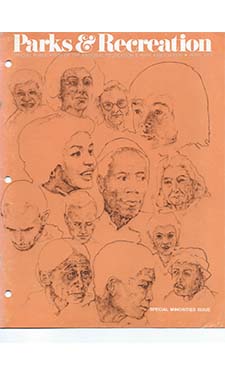 The April 1975 issue of Parks & Recreation magazine could be considered the Social Equity pillar issue of its day. The “Special Minorities Issue” attempted to examine the state of recreation as it relates to minority populations — a cursory glance reveals a focus on programming expectations for African-Americans, education, professional development and leadership, urban recreation, multicultural programming, women’s status in the industry and the so-called “Chicano” experience. A deeper dive, however, reveals park and recreation professionals in 1975 were discussing precisely the same issues of social equity then as we are today.
The April 1975 issue of Parks & Recreation magazine could be considered the Social Equity pillar issue of its day. The “Special Minorities Issue” attempted to examine the state of recreation as it relates to minority populations — a cursory glance reveals a focus on programming expectations for African-Americans, education, professional development and leadership, urban recreation, multicultural programming, women’s status in the industry and the so-called “Chicano” experience. A deeper dive, however, reveals park and recreation professionals in 1975 were discussing precisely the same issues of social equity then as we are today.
In our current issue, Founding Director and Counsel of The City Project Robert García tackles the subject of park and recreation access in underserved and low-income communities of color. García calls on state parks to examine their appeal to these populations, enjoining officials to “meet their needs.” Perhaps unsurprisingly, this is the exact call to action authors in the April 1975 issue prescribe.
Reading through V. Hap Smith’s opening piece, “A Black Man’s Concept of Leisure in America” is to be taken aback at what today would almost certainly viewed as radical rhetoric. Smith writes, “One of the problems in programming for black people is that white administrators do not understand black thinking and too often black people cannot articulate their needs and interests in terms which the white structure can readily understand. This communication gap is a critical void in the development of programs in basically black areas.” Indeed, throughout his piece, Smith writes candidly about the lack of black leadership in parks and recreation; the need for integration of poor and uneducated people in programming decisions; the communication disconnect between the white power structure and black patrons; and self-determination for blacks both in terms of park and recreation inclusion and, as he says, “society in toto.” It would seem that 40 years later, our industry continues to struggle to bridge the many gaps that disincentivise greater engagement with black and minority populations.
Also tracking with García’s piece is Donald J. Middleton’s article (with a Buzzfeed-worthy headline, no less), “10 Ways to Re-create Urban Recreation.” Middleton’s description of the plight facing American urban centers reads as if it were written just yesterday, as our country continues to struggle with income inequality and rising debt, and the impact that has on parks and recreation. “Urban recreation programming continues to be bound up in the fate of our cities — and the fate of our cities is still very much in doubt,” he writes. “The financial crises which plague our cities will undoubtedly put increasing pressure on urban recreation budgets. As our cities become homes for only the very rich and the very poor, urban recreation will come to be the exclusive province of the poor. The rich will continue to be able to purchase their recreation and to enjoy it largely outside of the city; the poor will become more and more dependent on publicly sponsored urban recreation programs.” He outlines his 10-point plan thusly: “(1) decentralize, (2) particularize, (3) set priorities, (4) integrate, (5) utilize local talent, (6) evaluate, (7) plan, (8) educate, (9) sensitize, and (10) publicize.” The details of Middleton’s points serve as a primer for today’s urban park and recreation professionals, urging them to innovate or face the consequences. “Urban recreation programming will succeed only to the degree that urban recreation leaders exercise initiative, creativity and sensitivity,” he writes.
As we continue to seek out ways to make parks and recreation inclusive for all Americans, it may be time for a history lesson. Although many gains have been made during the past four decades, we still have miles to go as we stress the importance of safe, accessible and desirable recreation programming in all areas of our country and for all its inhabitants.
Samantha Bartram is the Associate Editor of Parks & Recreation magazine.

